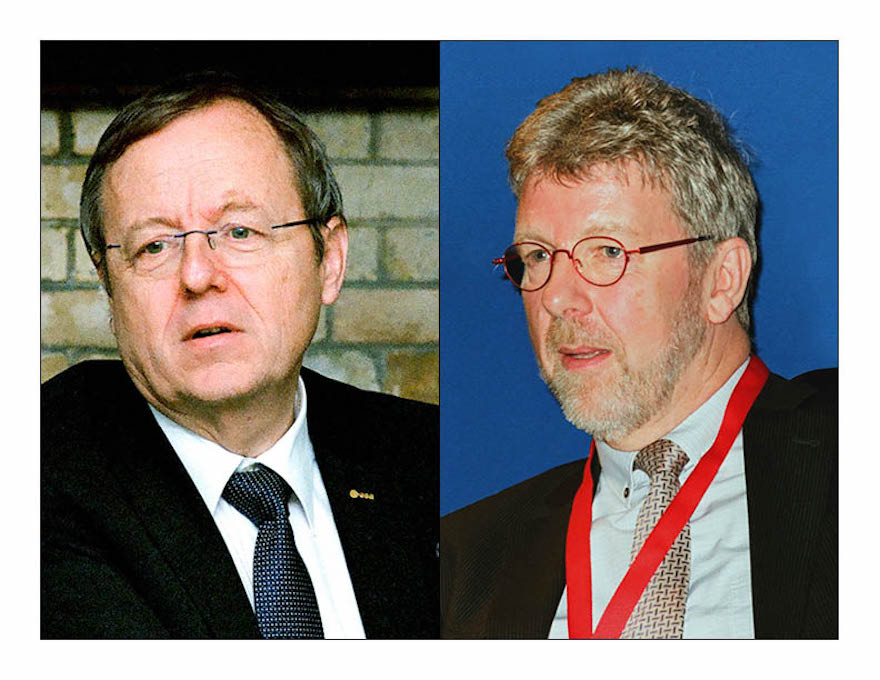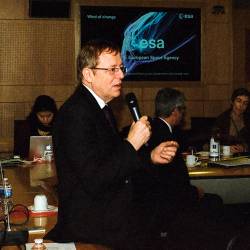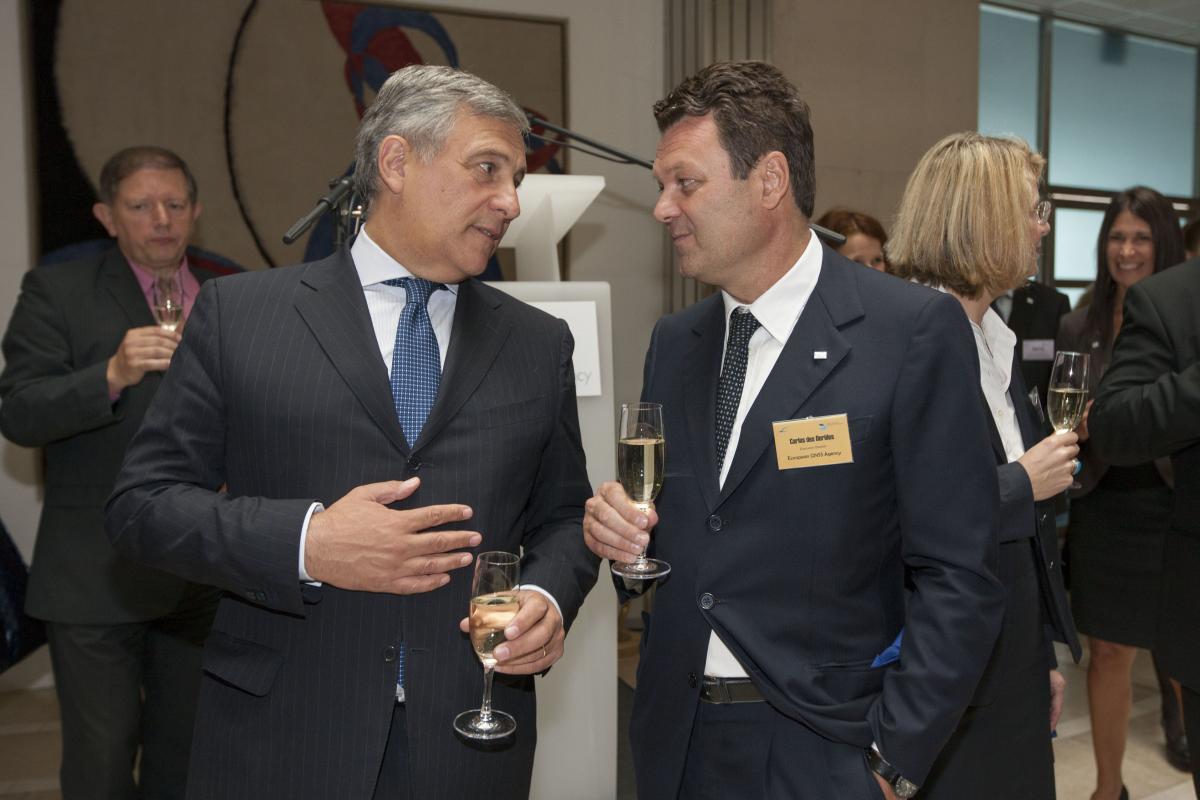European Space Agency (ESA) top brass welcomed journalists to the Agency’s headquarters in Paris for its annual New Year’s press launch. On hand was the Director General as well as ESA’s Galileo guru Paul Verhoef, who spoke one-on-one with Inside GNSS.
During his presentation to assembled journalists, ESA Director General Jan Woerner touched on a wide range of topics of interest to the Agency, from climate change to human exploration to budgetary matters and international cooperation, including a new agreement expected this year between ESA and the European Union.
About the European satellite navigation system, he said, “Galileo is operational, you can receive the Galileo data, and the accuracy, as I always hear, is three times better than the American GPS.” To his credit, Woerner made no effort to steer clear of what was perhaps the most memorable, if the most infamous event of the preceding navigation year, when the Galileo signal went missing for several days last July: “The Galileo incident of course we took very seriously,” he said, “together with the European Commission and also with the GSA [European GNSS Agency]. We have looked into the details to avoid such an event again.”
The microphone passed to ESA’s Director of Navigation Paul Verhoef, who said, “In terms of Galileo, successively over the next years we will reach full operational capabilities, depending on which service we are talking about. There is an infrastructure element, which is the completion of the constellation; currently we still have to add a few satellites in order to come to a full operational constellation. We will have a few reserves in orbit and then we already start replacing the first satellites.
[Photo: Jan Woerner, left. Paul Verhoef, right. Photos Peter Gutierrez, Inside GNSS]
“With regard to the incident,” he went on, “obviously this is something nobody wants, and if it has happened nobody would want it to be repeated, so a big effort has been underway. There have been a number of independent investigations into the incident, one organized by the European Commission and another internally by ESA where we have our Inspector General and two former Inspector Generals doing an investigation. There was work undertaken by the GSA, and we are in contact with industry in order to look into all of the aspects, including technical design aspects, operations and the rest. All of this material is coming together and at the moment measures are put in place. The purpose is obviously that this can never, ever happen again. It is not nice to have any outage, and an outage for six days on a system like this is just not something that we set ourselves as acceptable.”
What Happened
Verhoef spoke to Inside GNSS after the press conference, describing a series of unfortunate events that led to the malfunction. “If we would have intervened at any point during the sequence, the thing wouldn’t have failed,” he said, “but we didn’t.” One of the problems, as Verhoef retold it, was that the two ground-based control stations were not able to provide the expected redundancy. The procedure in place at the time involved one center taking over the tasks of the other while refits, upgrades and other work was carried out. “So what you see is there is a constant handover of operational tasks between the centers and this was not necessarily robust enough.” But this was not the only problem. “There was also indeed a technical anomaly,” Verhoef said. “There was temporary equipment that was there because we were still in the initial deployment, and there was a problem with this equipment, and then there were operations mistakes. No, we had the whole thing. I say this not as an excuse, but Galileo is a complex system and we are still discovering some of the consequences of this complexity, and obviously we are now putting all efforts on further improving the robustness to make sure that this doesn’t happen again.”
NAVIS: Beyond the Earthly Sphere
Back at Woerner’s presentation, the General Director pointed out that Galileo and EGNOS are not the only areas of activity for the Agency’s Navigation section. “Of course at ESA we implement Galileo,” he said, “but in addition we have NAVIS, where here we are looking to not only to applications on the surface of the earth but also for outer space navigation systems.”
About expanding the reach of ESA’s navigation activities, Verhoef told us, “We consider that there are a number of tasks we can do in areas aside from our infrastructure delivery for European GNSS Galileo and EGNOS. With NAVIS, the Navigation, Innovation and Support Program, which we set up in 2016, we can do a number of other things that we feel are important in navigation.”
Verhoef said ESA is not looking to elbow in on the GSA’s work with downstream industry, “but there are a whole lot of activities and research projects among the scientific community using GNSS signals, and we have decided that we want to support them,” he said.
Through NAVIS, ESA is also working with its own member states that have navigation-related needs, and with actors in other application areas. “There are whole ranges of applications and receiver technologies which need to have a very close coupling to the functioning of the system,” Verhoef said. He cited the rail sector, where trains need seamless navigation services even while moving from above ground into tunnels. “You first need to decide how to use an application within the system in an optimal fashion. On our side, we can say to developers that we have a number of things we could possibly tweak on the existing navigation system to help them, and then, once that is done, they can go on and build their applications.”
Looking beyond the limits of global navigation, Verhoef said, “ESA Navigation, with our Exploration and Telecomms colleagues, and in coordination with NASA, are working together to design communications and navigation services for flights to the moon and for activities on the moon. We have two environments that we are looking at. One is more general navigation, but if you have, for example, robotic exploration on the moon then you also need rather precise navigation capabilities. Having permanent lunar infrastructure in place – we have already looked into this – is a lot cheaper than having every mission bringing its own capabilities. This means possibly satellites around the moon, infrastructure in The Gateway, possibly some stuff on the surface of the moon.”
The Gateway, as envisaged by NASA, will be a small spaceship in orbit around the Moon providing living quarters for astronauts, a lab for science and research, ports for visiting spacecraft and, importantly, access to the lunar surface.
Verhoef said ESA has done phase zero feasibility studies for a moon navigation system, and, “We are now going to move forward, continuing with system studies. Obviously our industry is interested. We will have to decide how these services are going to be provided, what the role of the private sector is and of the public sector. All that needs to be looked into, apart from technology aspects.”
Galileo II
While completion of the Galileo constellation is still a work in progress, ESA is already looking ahead to the system’s second generation. “Given the lead time on doing new things,” said Verhoef, “between the moment that you start thinking about it and then you determine how you want to do it and then you get the budget and you do the design and the procurement and the deployment, testing and qualification, you need to launch the satellites and upgrade your ground installations… there is about 15 years gone between the moment you start to think about it and the moment you’re actually able to provide a service to the public.
“We started on the second generation four or five years ago, the first ideas, first studies, first technology development. We have extensively talked to the member states and the GSA has looked into the wishes from the market.” Galileo II will proceed in steps, he said. “The first step we’ve already taken practically, which is the procurement of the transition satellites. They will be very advanced satellites with a lot of new capabilities.”
Verhoef said among those new capabilities will be increased flexibility: “We want to be able to reconfigure, even at the level of signals and at the level of power.” The current trend, he said, sees all GNSS moving towards delivering a more powerful signal that is more easily detectable, more robust, more difficult to interfere with and easier to process, thus saving processing power in smartphones and other navigation devices.
“Now, if we want more power, then the satellites need to be bigger,” he said. “And this brings the question of how you launch that. We are very likely going to go to electric propulsion, launching two satellites at a time, with a higher weight in a lower orbit in order to stick to the Ariane 62 capability, so that will be one of the design parameters. And with the capabilities we want, you probably will need intersatellite links.”
In all areas, he said, the key is responding to users’ needs. “For us, the proxy for the end users is the chipset manufacturers, who have now a number of years of experience with Galileo. For the moment we know that most chips are geared towards capturing GPS first and then Galileo as a second signal to help. We of course would like to put up a bit of competition to that, but for that we need to change the nature of our signals so that it is easier to capture a Galileo signal in the first instance.”
Verhoef pointed out that with Galileo II his team is not starting from scratch. “We’re going to have to change the system from its current operational capabilities to the new operational capabilities while we are in operation, so this is an extra complexity and it’s also going to cost more time. All of that is now being brought together and this year there will be a decision to go ahead with the second generation. Then we will formally kick off the start of the full procurement with a first availability of capabilities probably in the timeframe 2026-28.”
Brexit Nigh
The opening of ESA’s New Year came in the wake of a UK general election that appeared to finally seal the country’s departure from the European Union. But even as steadfast ‘remainers’ in the UK held out hopes that the ‘scission decision’ could still be reversed, Galileo had already moved on, having begun the process of peeling away UK participation in the program well in advance of the UK actually leaving the EU.
“Brexit does mean something to Galileo and it has already,” said Verhoef. “The UK industry is by and large out of the program, SSTL being one of the last ones still currently executing a contract.” As soon as Brexit kicks in, he explained, the UK will not have an agreement to participate in Galileo. “So that means for all new procurements, in principle, UK industry cannot participate unless there are particular reasons, for example because they are capable of doing something which in the rest of Europe is very difficult or impossible.
“The second issue is that there can no longer be access by the UK government, UK nationals or UK industry to Galileo PRS [Public Regulated Service] information. And as a result we have had to take out a number of British companies from the program. In general, companies were able to continue the contracts they had, but there is now only one contract which is still ongoing, the SSTL contract on payloads. Having said that, there are a number of classified tasks even on that contract which, after Brexit, will no longer be done by SSTL.” These tasks, he explained, will be taken over by a company on the continent, at the ESA ESTEC facility in the Netherlands, and from there the payloads will go to Bremen, to OHB for integration.
“That is the consequence, unfortunately both for the UK but also for us; it is a pity that we lose these capabilities,” Verhoef said. “And also, unfortunately, we are going to have to move a number of our own British ESA colleagues who are working on Galileo to other parts of the Agency, because they can no longer have access to classified information.
“It is not that this is specifically done for the UK, per se,” he said, “but it is the result of the rules imposed on us about what EU member states and those who have agreements with the EU, like Norway and Switzerland, can have access to, and what non-EU member states can have access to. The UK accepts all of these consequences because they were part of the EU member states who determined the rules.”






